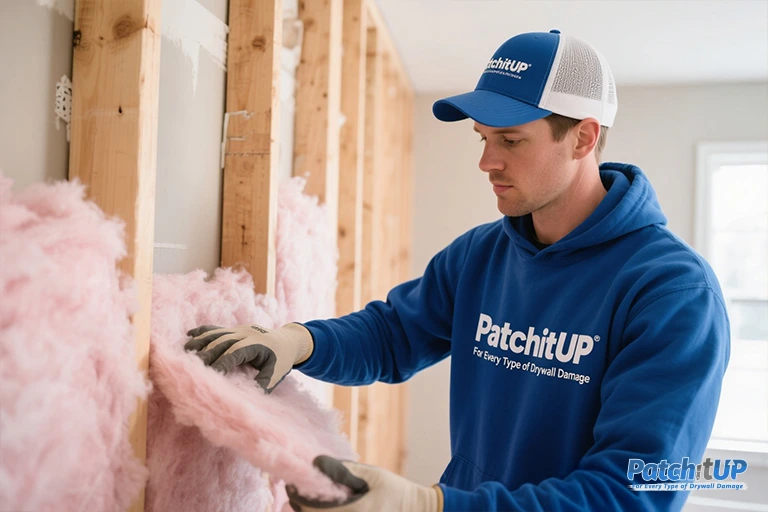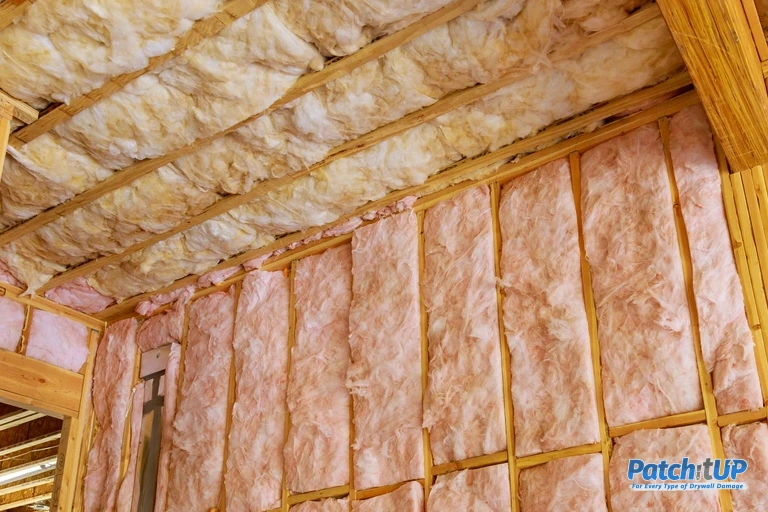Spray Foam vs Fiberglass: Choosing the right insulation for your home is one of the most important steps to improve energy efficiency, comfort, and long-term savings. The two most common options are spray foam insulation and fiberglass insulation, but they work very differently, have different costs, and are better suited for different parts of a house. Understanding how each one performs will help you make the right choice.

What is Fiberglass Insulation?
Fiberglass insulation is made from fine glass fibers. It usually comes in the form of batts, rolls, or loose-fill. It traps air between the fibers, slowing down heat transfer and keeping indoor spaces warmer in winter and cooler in summer. It is lightweight, easy to install, and commonly used in attics, walls, and ceilings.
- Pros: Affordable, DIY-friendly, widely available, good for large open spaces.
- Cons: Does not stop air leaks on its own, can lose effectiveness if compressed or wet, may cause skin irritation during installation.
What is Spray Foam Insulation?
Spray foam insulation is a liquid that expands and hardens after application, filling cracks, gaps, and irregular surfaces. It provides both insulation and air sealing in one step. There are two main types:
- Open-cell spray foam – Softer, flexible, and less dense. It allows some moisture vapor to pass through, making it suitable for interior walls and rooflines. It is also very effective at absorbing sound.
- Closed-cell spray foam – Denser, rigid, and has a higher R-value per inch. It also acts as a vapor barrier and resists water, making it ideal for basements, crawl spaces, and areas prone to moisture.
- Pros: Excellent air seal, higher R-value (especially closed-cell), moisture-resistant, reduces drafts and improves comfort.
- Cons: More expensive, requires professional installation, curing process releases chemicals that need proper ventilation.
R-Value Comparison (Thermal Resistance)
The R-value measures how well insulation resists heat flow. Higher R-values mean better insulation.
- Fiberglass: R-2.9 to R-3.8 per inch
- Open-cell spray foam: R-3.5 to R-3.8 per inch
- Closed-cell spray foam: R-6 to R-7 per inch
This means closed-cell spray foam delivers twice the insulation value of fiberglass in the same thickness. It is especially useful when space is limited.
Air Sealing and Moisture Control
- Spray Foam: Provides an airtight seal by filling cracks and gaps, which prevents drafts, pollen, and dust from entering. Closed-cell also resists moisture, reducing risks of mold.
- Fiberglass: Good at slowing heat transfer, but it does not block air leaks. If air sealing is not done separately, fiberglass can perform poorly. Moisture can also reduce its effectiveness.
Comfort and Indoor Environment
- Spray foam keeps indoor temperatures more stable by blocking air movement. Homes feel less drafty and heating/cooling systems work more efficiently.
- Fiberglass can also provide good comfort if installed correctly with proper air sealing, but without sealing, rooms may feel uneven in temperature.
Soundproofing
- Best: Open-cell spray foam and fiberglass – both absorb sound effectively and are often used in interior walls.
- Moderate: Closed-cell spray foam – because it is dense, it reflects sound more than it absorbs.
Cost and Installation
Fiberglass insulation: Cheapest option and easy for homeowners to install themselves. Professional installation is also fast and affordable.
Spray foam insulation is more expensive, with closed-cell costing the most. Must be installed by trained professionals to avoid issues.
Even though spray foam vs fiberglass insulation shows a cost difference, many homeowners recover the investment through lower energy bills over time.
Durability and Maintenance
- Fiberglass: Can settle, compress, or lose effectiveness if it gets wet. However, it is easy to replace or add more later.
- Spray Foam: Long-lasting and does not shift or settle. Quality depends on proper installation, so choosing experienced installers is critical.
Safety and Health
- Spray Foam: Gives off strong fumes during installation and curing. Professionals use protective gear, and the space should be ventilated until safe. After curing, it is stable.
- Fiberglass: Can irritate skin and lungs during installation. Wearing gloves, masks, and protective clothing is recommended.
Environmental Impact
- Fiberglass: Often made with recycled glass, making it more eco-friendly.
- Spray Foam: Uses chemicals and blowing agents, some of which may have environmental effects, though newer low-impact versions are available.
- Both reduce energy use in the long run, lowering your carbon footprint.
Where Each Works Best
- Fiberglass: Attics, open wall cavities, ceilings, and areas where cost savings matter most.
- Open-cell Spray Foam: Interior walls and rooflines, where sound control and air sealing are important.
- Closed-cell Spray Foam: Basements, crawl spaces, rim joists, metal buildings, and areas with moisture or limited space.
| Feature | Spray Foam Insulation | Fiberglass Insulation |
| Material | Expanding liquid that hardens into foam | Fine glass fibers (batts, rolls, or loose-fill) |
| Types | Open-cell (soft, soundproofing), Closed-cell (rigid, moisture-resistant) | Batts, rolls, loose-fill |
| R-Value per Inch | Open-cell: R-3.5 to R-3.8 Closed-cell: R-6 to R-7 | R-2.9 to R-3.8 |
| Air Sealing | Excellent – fills cracks and gaps | Poor – requires separate air sealing |
| Moisture Resistance | Closed-cell resists moisture and acts as vapor barrier | Can lose effectiveness if wet |
| Sound Control | Open-cell = excellent Closed-cell = moderate | Good at absorbing sound |
| Durability | Long-lasting, doesn’t settle if installed correctly | Can sag, compress, or settle over time |
| Comfort | Very stable indoor temperature, reduces drafts | Good, but drafts possible if leaks are not sealed |
| Installation | Professional only (special equipment needed) | DIY-friendly and quick for professionals |
| Cost | Higher upfront cost (closed-cell most expensive) | Lower cost, budget-friendly |
| Health & Safety | Off-gassing during install, needs ventilation; safe after curing | Can irritate skin/lungs during install; safe once installed |
| Environmental Impact | Higher footprint (chemical-based), though low-GWP versions available | Often made with recycled glass, more eco-friendly |
| Best Use Areas | Basements, crawl spaces, rim joists, attics (roofline), tight or damp areas | Attic floors, walls, ceilings, large open spaces |
| Lifespan | 20–30+ years with proper install | 15–20 years; may need topping up sooner |
| Return on Investment | High due to energy savings and comfort improvements | Moderate; lower upfront cost but less energy savings |

Final Thoughts:
- Choose fiberglass insulation if you want the most affordable and DIY-friendly solution, especially for attics and walls. Just make sure to combine it with proper air sealing.
- Choose spray foam vs fiberglass insulation carefully if you want maximum performance, airtight sealing, and moisture protection. Closed-cell spray foam is best for tight spaces and damp areas, while open-cell is great for soundproofing and wall cavities.
- Many homes benefit from a combination of both: using spray foam vs fiberglass insulation strategically — spray foam in critical areas (like basements or rim joists) and fiberglass in large spaces like attics.
FAQ Spray Foam vs Fiberglass: Which Insulation Is Right for You:
- Why is spray foam insulation better?
A. Spray foam is better because it seals air leaks, has higher R-value, controls moisture, and makes homes more energy efficient and comfortable.
- What are the disadvantages of spray foam insulation?
A. It is expensive, needs professional installation, and can release fumes during curing.
- Can you use spray foam and fiberglass insulation together?
A. Yes, many homes use both. Spray foam seals gaps in key areas, and fiberglass covers large spaces cost-effectively.
- Which insulation is better?
A. Spray foam gives better performance, but fiberglass is cheaper. The best choice depends on budget, space, and home needs. - Is spray foam vs fiberglass insulation better for my home?
It depends on your needs. Spray foam vs fiberglass insulation offers different benefits—spray foam provides superior air sealing, higher R-value, and moisture resistance, while fiberglass is more affordable and DIY-friendly. The best choice comes down to budget, space, and performance goals.
Related Post:
- Common Mistakes in DIY Plaster Repair (And How to Avoid Them!
- Best Tools for Drywall Repair in 2025: What Pros Recommend!
- Why You Should Never Ignore Small Drywall Holes!
